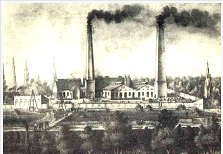
Położenie kamienia węgielnego pod budowę Huty Hermina (zdjęcie Huty Hermina ok. 1860 r.)
Huta Łabędy (Łabędy steelworks) is one of the oldest steelworks in Poland, whose history dates back to the first half of the 19th century. It played a key role in the development of the steel industry in Upper Silesia, becoming an important element of the Polish economic landscape.
The history of Huta Łabędy begins in 1848, when the foundation stone for the construction of “Hermina” steelworks was laid on 14 August in the town of Łabędy, near Gliwice. The investors were Moritz Izaak Caro, a rich wholesaler of ferrous materials from Wrocław, and his son Robert Caro, and the steelworks was named after Robert’s wife, Hermina.
It was the period of intensive development of industry in Upper Silesia, where the discovery of large deposits of hard coal and iron ore created favourable conditions for the construction of steelworks and mines. The Hermina steelworks was a response to the growing demand for steel products, especially in the rapidly developing railway, construction and engineering industries.
It developed dynamically, implementing modern technological solutions. It was the first place in Silesia where electric lighting was installed in 1882. Initially, the plant produced mainly pig iron, steel and various castings for the construction and railway industries.
During the inter-war period, the Hermina steelworks underwent a number of modernisations, which helped to increase its efficiency and production. During World War II, it was transformed into a plant fulfilling the needs of the armaments industry.
After the war, the steelworks became one of the pillars of the economy of the Polish People’s Republic, contributing to the reconstruction and development of the country. On 1 April 1950, a state enterprise was established under the name “Huta Łabędy”. In the years of the Polish People’s Republic, it was one of the pillars of heavy industry, ensuring the economic stability of the region.
After the political transformation in Poland in 1989, Huta Łabędy had to face the challenges of restructuring and adjusting to modern market standards. In the 1990s, the plant underwent reforms with the purpose of improving production efficiency and introducing innovative technologies. On 1 January 1998, the state-owned enterprise was commercialised and Huta Łabędy S.A. was created.
As a result of ownership transformations, three subsidiaries were established, forming the Huta Łabędy S.A. Group of Companies:
Zakład Energo-Mechaniczny ZEM Łabędy Sp. z o.o. – specialising in utility transmission, renovation of industrial installations and welded structures.
EKO-PRO-HUT Sp. z o.o. – involved in processing of steel slag and production of aggregates for road construction.
VENUS Sp. z o.o. – leisure and recreation centre.
Presently, Huta Łabędy S.A. functions within the Węglokoks S.A. Group of Companies, engaging in social and sports initiatives and supporting technical education, e.g. by creating patronage classes.
In 2023, Huta Łabędy celebrated its 175th anniversary, acknowledging the development and changes that have taken place over the years and recognising the contribution of former and present employees. Thanks to its investments and commitment to environmental protection, the steelworks continues to play a key role in Polish industry and the Upper Silesian region.
Although its operations have encountered numerous challenges, due to both economic transformation and global trends, the plant remains an important part of Polish industry. Thanks to modern investments and a commitment to environmental protection, Huta Łabędy has a chance to continue its mission as an important player in the steel market, contributing to the development of the region at the same time.
In 2023, Huta Łabędy celebrated its 175th anniversary. The changes and development that took place over the years, and its current shape, are the result of the work of many great people, former and present employees.